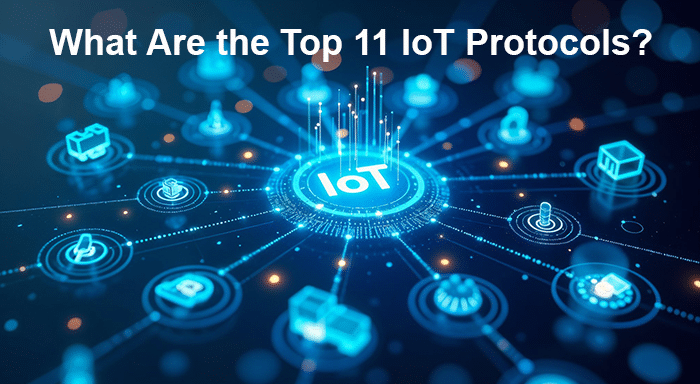The internet of things is a revolutionary technology that connects devices via a digital network. Its main features include collecting data through insights, automating tasks and enhancing connectivity.
IoT allows real-time monitoring to generate data-driven insights of different fields and industries. It’s an evolving technology, and the estimated growth rate of IoT is around 14.6% to 15.12% from 2025 to 2030. Integration of IoT with networked devices enhances operational efficiency and user convenience. Research suggests that there are at least 27 billion IoT devices worldwide. IoT has completely changed how devices communicate with one another, how things travel from one place to another, and how we track things and make decisions.
IoT has significantly influenced the current technological world, from upgrading home automation and streamlining industrial processes to improving safety mechanisms. IoT protocols are core aspect of the IoT technology, developers and engineers should be aware of these protocols. To create better IoT ecosystems, developers and engineers need to be aware of IoT protocols as the technology develops and spreads. The foundation of Internet of Things technology, these protocols guarantee effective data synchronization, safe encryption, and smooth communication and device compatibility.
What Is IoT?
The Internet of Things (IoT) is nothing but a sophisticated network of vehicles, appliances, physical devices, sensors, etc. to create a smart environment for seamless connectivity and data exchange. The main purpose of IoT is to collect, analyze, and share data, which further ensures remote tracking and control of numerous systems. IoT systems can be used to automate tasks, upgrade efficiency, and give valuable insights in both industrial and personal environments. IoT can be used in several industries including healthcare, agriculture, home automation, etc.
What Are IoT Protocols?
It can be described as a set of standards or rules that define how IoT devices will work or interact in an IoT environment. By leveraging protocols of IoT, an organization or a company can make sure that data recorded by IoT devices is correctly received and interpreted at every stage. The core need of these protocols is to ensure that there is seamless communication between IoT devices irrespective of platform or manufacturer. Not all protocols are similar and it is important to know the differences between them.
Top 9 IoT Protocols
Various types of protocols are utilized in IoT like HTTP, MQTT, LoRaWan, etc. Let us go through each of these protocols in detail-
MQTT (Message Queuing Telemetry Transport)-
Ideal for devices that work with limited data and power, it is one of the simplest protocols for messaging out there. Technically, it is a suitable protocol for applications, typically battery-powered devices, requiring low-bandwidth connections in remote locations. Essentially, it is the right protocol to choose for scenarios that need low data and energy. It is referred to as a lightweight messaging protocol that operates on the publish/subscribe model. The lightweight and simple architecture has contributed to its widespread adoption in the world of IoT.
CoAP (Constrained Application Protocol)-
CoAP was designed to focus on the specific requirements of the HTTP-based IoT systems. To ensure, there is a safe connection between two IoT endpoints, this protocol depends on UDP (User Datagram Protocol). It is ideal for devices and networks that are more locally restrained. CoAP is known to be quite efficient, lightweight, and reliable and is mainly used in applications such as microcontrollers, automation, and mobiles. It is important to know the important differences between MQTT vs COAP to choose the best protocol for IoT connectivity requirements.
AMQP (Advanced Message Queuing Protocol)-
It is generally considered an open standard software layer protocol mainly applicable in message-based environments configured for queuing and routing. It is mainly leveraged for point-to-point connections and facilitates smooth and protected data exchanges between cloud and connected devices. Majorly, it consists of three main components namely: Message Queue, Exchange, and Binding.
The three components work together to establish a safe and effective exchange and storage of messages and set up unique relationships between these messages. The main application area of this protocol is the banking industry.
LoRaWan (Long Range Wide Area Networks)-
It can defined as a low-power and long-range IoT protocol that ensures detection of signals below the noise level. LoRaWan mostly connects IoT objects that are battery-powered in wireless settings for global or private networks. In high-scale applications of IoT like smart cities, this protocol can be utilized since it will deal with millions of IoT devices consuming low memory and power. For example, smart street lighting is one of the practical use cases of the LoRaWan protocol.
HTTP (Hyper Text Transfer Protocol)-
It is one of the most common and ubiquitous internet protocols in the world. It is one of the cornerstones of the World Wide Web and has been used for data communication and loading online pages. In IoT applications, it is extensively used when users need to publish a high volume of data. The reason it is not preferred in a broad range of IoT use cases is due to its heavy weight, energy savings, high cost, battery life, and other constraints.
Its common use cases include smart home dashboards, 3D printing, additive manufacturing, RESTful APIs for distinct IoT applications, and remote tracking platforms.
Wi-Fi (Wireless Fidelity)-
It is another widely-used internet protocol that is intensely used in the modern world for connecting diverse devices in proximity to one another. A general Wi-Fi connection can be achieved either via a broadcasting signal or through a Wi-Fi hotspot. A typical connection needs multiple radio waves to broadcast data on particular frequencies like 5GHz, 2.5GHz, or 6GHz channels.
The recent Wi-Fi 6E is expected to be one of the biggest breakthroughs as far as IoT connectivity is concerned. From computers, smart TVs, drones, and cars, to AI/VR goggles, all modern appliances need Wi-Fi to work.
ZigBee-
It is a mesh protocol that enables low-power and low-cost machine-to-machine and IoT networks. It enables smart IoT objects to collaborate and is a vital component of home automation. However, it is also commonly utilized in industrial applications, typically those that need low-rate transfer of information over short distances. Common use cases of ZigBee protocols advanced security systems include smart homes, electric meters, and street lighting.
LPWAN (Low-power Wide Area Networks)-
It is a prominent IoT protocol and a wireless technology that covers a wide coverage area and requires little power. In IoT applications, where there is irregular transfer of small bits of information, this protocol proves to be quite handy. The major advantage of LPWAN technology is the fact that it allows IoT devices to be tethered directly to the internet which reduces the need for integrating IoT gateways. LPWAN technology is suitable for use cases where there is a need for long-range connectivity, real-time communication, and low-power consumption.
Sigfox-
It is a type of LPWAN protocol (wide-area network) that has been specifically developed for IoT applications. Using this protocol, users can seamlessly connect IoT systems to the internet with minimum bandwidth and energy. This makes this protocol relevant for use cases where long battery life is a necessity but high data transfer rates are not. It sends small data sets consuming minimum energy. Essentially, it finds its use in applications where users only need occasional data updates. The main use cases of this protocol include smart meters, environmental sensors, shelf updates in retail stores, healthcare applications, etc.
Conclusion
Since billions of IoT devices are already enabling the world to connect better, it is important for the users and engineers to understand how IoT works. The blog focuses on one of the vital aspects of the IoT functioning that determines connectivity between devices: IoT protocol. Through understanding and utilizing these protocols (like MQTT, CoAP, LoRaWAN, etc.), developers could design durable and scalable IoT solutions. By leveraging appropriate protocols, we can create more connected IoT systems that improve both our everyday lives and the infrastructure of the entire world.
For more blogs on IoT and IoT-enabled technologies, check out the blog section of our website



